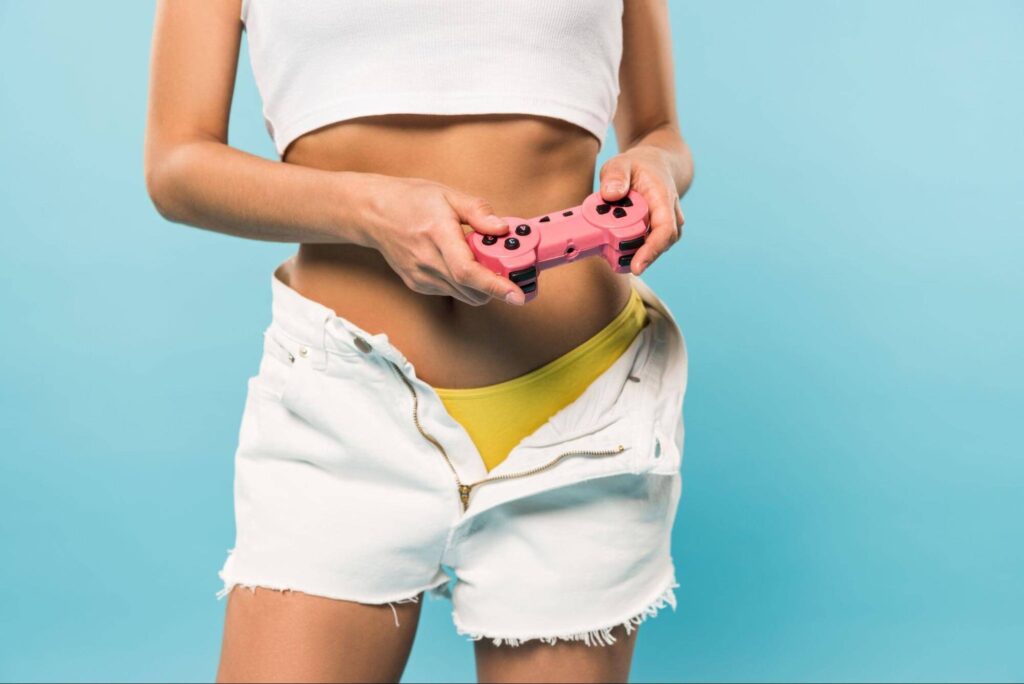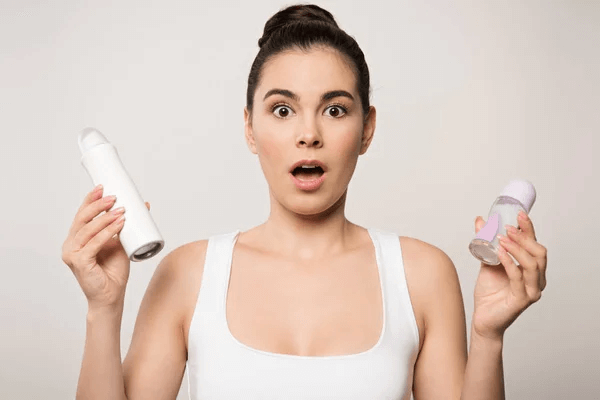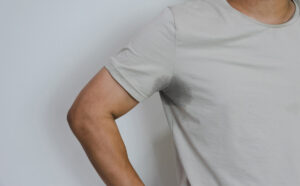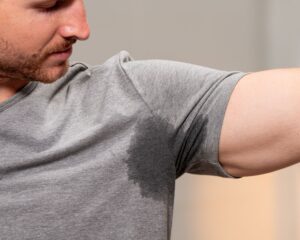What's in this Article?
Let’s face it, groin sweat can lead to some rather embarrassing moments. When your sweat is visible and makes you feel smelly, slimy, and self-conscious—it isn’t just bad, it’s darn bad (and gross, too). There’s nothing like a sweaty crotch to put a damper on your day. If you’re wondering how to stop groin sweat, here are some ways that can help:
The Lowdown on Groin Sweat
Everybody knows that sweat is the mechanism by which the body cools itself and maintains its core temperature. You probably also know that the underarms, crotch, hands, feet, and forehead are the places we sweat most and most often.
The reason that these areas of the body are more prone to excessive sweating than others is no mystery: It’s just a matter of numbers.
The average person has about 2 million sweat glands. Some people have as many as 4 million sweat glands. There are two kinds: eccrine and apocrine. Eccrine sweat glands are distributed just about everywhere on the body (ear canals, lips, and genitals are the exceptions). The sweat they secrete is clear and mostly made up of water, salt, and electrolytes.
Apocrine glands are found in abundance in and around your armpits, scalp, eyelids, and nipples. They’re concentrated around areas where there are lots of hair follicles. This includes the groin region in both men and women. The sweat secreted by apocrine glands is different—it’s thick and yellow in color and much of it reaches the skin’s surface by way of hair canals. This type of sweat contains much higher concentrations of fatty acids and proteins.
Ladies: There are no sweat glands on the vagina, but there are very high numbers of apocrine sweat glands around the outside of the vagina on the labia majora.
When these fatty acids (lipids) and proteins arrive on the skin’s surface, millions of bacteria are waiting and eager to gorge themselves. As the bacteria break down lipids and proteins, smelly acids are left behind. This causes body odor and that terrible smell we know all too well.
What Causes Excessive Groin Sweating?
First of all, it’s not unusual to sweat between the legs, thighs, and in the groin area. Hot, muggy weather and physical exertion will cause you to sweat, especially down there. The sheer number of sweat glands in the groin can cause profuse sweating.
If hot temperatures or physical exertion are not the cause of your excessive groin sweat, something else may be at work. That something else is called hyperhidrosis. It’s a medical condition that affects an estimated 3% of the population.

There are two kinds of hyperhidrosis: generalized hyperhidrosis and primary focal hyperhidrosis. Generalized hyperhidrosis is excessive sweating over your entire body. It is usually caused by an unrelated underlying condition, like diabetes, cancer, or other disease or disorder.
The other type of hyperhidrosis—and the prime suspect for overactive sweat glands in the groin area—is called primary focal hyperhidrosis. It usually affects one specific area of the body, i.e. the underarms, face, head, hands, feet, or the groin.
Common Causes of Groin Sweat
So, why does your crotch sweat so much? Here are several likely causes:
High Temperature
Even minimal moving around in hot environments will cause you to sweat in the groin area.
Exercise
Any form of vigorous exercise will cause you to sweat in the crotch (and other places). Exercise that’s focused on the lower body will produce more sweat in and around your groin.
Pubic Hair
Because apocrine glands are found in and around the groin, pubic hair traps bacteria and moisture from sweat, creating a virtual greenhouse for bacterial growth. The rapid surge in bacterial population causes itching, discomfort and groin sweat odor. If proper cleansing does not take place, the buildup of sweat and bacteria can lead to groin sweat rash, thigh chafing, and infection.
Bad Underwear
There is good underwear, and then there’s bad underwear. We’re not talking about your Batman briefs. We’re talking about underwear that’s made of synthetic fabrics that don’t breathe. These types of undies don’t wick away moisture and they trap sweat and heat in the groin area. Always choose underwear made from natural, breathable fabrics that can absorb and wick away moisture and allow ventilation. Natural fabrics are also non-allergenic and less likely to cause a rash.
Obesity
You knew it was coming. If you’re carrying extra weight, the chances of excessive groin sweat are much higher. The body is naturally insulated by fat. Excess fat in and around the hips, stomach, and thighs will cause excessive groin sweating.
Feminine Hygiene Products
Many panty liners and pads are made of materials that don’t breathe. Wearing them may increase the temperature down there, resulting in increased vaginal sweating. If you must wear pads and panty liners, be sure to change them at frequent intervals.
Lack of General Hygiene
This probably goes without saying: good hygiene is critical if you’re looking for how to stop groin sweat.
Clean your groin area every day, either by bathing, taking a shower, or using a cleansing wipe. To win the battle of groin sweat, you have to start out right—and that means starting out clean.
Hyperhidrosis
Uncontrolled and excessive groin sweat may be a sign of hyperhidrosis. Generalized hyperhidrosis is excessive sweating all over the entire body. Primary focal hyperhidrosis is sweating in one particular part of the body. If you’re experiencing excessive and profuse sweating only in the pubic area, you might be suffering from primary focal hyperhidrosis. A qualified doctor can make that diagnosis.
Menopause
The changing hormone levels in women over the age of 45 often cause hot flashes, which can lead to heavy perspiration—even in the crotch region. Night sweats are also commonly associated with menopause.
Anxiety or Stress
If you’re sweating a lot, it may be due to anxiety and stress.
Diabetes
Diabetes can cause glucose levels to swing wildly, which in turn can cause excessive sweating in both men and women.
Hyperthyroidism
Hyperthyroidism is caused by an overactive thyroid gland. Other symptoms include weight loss, elevated heart rate, nervousness, and fatigue.
Groin Sweat in Women
Sweating in groin area and inner thighs in females is often caused by a combination of factors, including:
- Hormonal changes: During menstruation, perimenopause, and menopause, hormonal fluctuations can lead to increased sweating and dampness in the groin area.
- Feminine hygiene products: Wearing tight-fitting underwear, panty liners, or pads can trap moisture and heat, promoting sweating.
- Sweat-inducing activities: Exercise, hot weather, and humid environments can all increase sweat production, including in the groin area.
Specific Triggers for Women
In addition to the general causes mentioned above, there are some specific triggers that may exacerbate groin sweat in women:
- Clothing choices: Wearing tight-fitting clothing, especially synthetic materials that don’t allow for breathability, can trap heat and moisture, leading to increased sweating.
- Underwear type: Choosing cotton underwear, which allows for better airflow, can help reduce dampness and discomfort.
- Dietary factors: Consuming spicy or hot foods can stimulate sweat glands, including those in the groin area.
- Night sweats: Night sweats can sometimes occur in the groin area, particularly in women experiencing menopause or certain medical conditions.
Groin Sweat in Men
In men, groin sweat is primarily caused by:
- Sweat glands: Men tend to have more sweat glands in the groin area than women, making them more prone to sweating in this region.
- Testosterone: Testosterone, the primary male sex hormone, plays a role in regulating sweating. High levels of testosterone can increase sweat production.
- Athletic activities: Strenuous exercise, particularly those involving physical contact, can lead to excessive sweating in the groin area.
Specific Triggers for Men
In addition to the general causes mentioned above, there are some specific triggers that may exacerbate groin sweat in men:
- Pubic area shaving: Shaving the pubic area can irritate the skin and make it more sensitive to sweat.
- Athletic wear: Wearing tight-fitting athletic wear, especially synthetic materials, can trap heat and moisture, leading to increased sweating.
- Certain occupations: Men in physically demanding jobs, such as construction or firefighting, may experience more groin sweat due to the nature of their work.
- Night sweats: Night sweats can sometimes occur in the groin area, particularly in men experiencing certain medical conditions, such as prostate problems or sleep disorders.
10 Ways to Deal with Groin Sweat
1. Choose Your Clothing Wisely
One simple yet effective way to stop sweating and prevent that heat-related groin rash is to wear the right clothing. Synthetic fabrics like rayon and polyester are tightly woven and don’t allow adequate ventilation. While they can wick away moisture, they will retain groin sweat odors. Use caution when choosing clothes made from these fabrics. Some synthetic blends are breathable and are moisture wicking, too.
Clothing made from natural fabrics, like cotton, linen, and wool, are breathable fabrics which allow air to reach the skin. These fabrics (except cotton) also will wick away perspiration, allowing it to evaporate. Cotton, while super absorbent, holds on to moisture longer than other natural materials—and even other synthetic fibers. Silk is also a natural fiber but is not moisture wicking. Silk hangs on to odor, requires special care, and is fragile.
2. Loose is Better Than Tight
You may love your skinny jeans and tight leggings, but when it comes to groin sweat, they won’t love you back. Pants that are tight in the crotch area are going to spike the thermometer down there. If you’re wearing skin-tight clothing, fabric will rub against your skin. Friction creates heat. Then heat and friction are going to gang up on you, making you sweat. The sweat will make you feel uncomfortable, and when bacteria are added to the equation, the result can be offensive sweat odor along with the potential for a burning groin sweat rash.
Instead, to minimize heat and moisture, you should opt for loose-fitting pants. Looser pants will provide plenty of room for movement without creating friction. Less friction means less heat, and less heat means less crotch sweat. Loose joggers are great for casual days. For other, less casual situations, choose something comfortable that won’t rub you the wrong way.
3. Sweat-Resistant Underwear
When it comes to underwear, it’s best to choose function over fashion. Sweat-friendly fabrics are especially important when choosing what to wear underneath it all.

Many manufacturers within the athletic apparel industry have developed special fabrics that do a great job of wicking away moisture so it can evaporate. If sweat is allowed to evaporate quickly, bacteria won’t be able to breed and multiply.
These new, space-age fabrics are capable of not only moisture wicking, but they can even help regulate temperature, neutralize odor, and fight bacteria. Bamboo underwear, for example, is rapidly growing in popularity. Underwear made from bamboo is soft and moisture wicking. Additionally, it can help regulate temperature and kill bacteria. Sweat-proof underwear that will help prevent groin sweat is available for both men and women.
4. Change Your Clothes
It may be obvious, but another simple way to control the problem of sweat glands on the rampage is to change your clothing after experiencing a crotch-sweating episode. This is more easily done when at home or after a workout at the gym, but what about other situations? Yes, it could get awkward and may not be an option at times.
You’ll want to do this for a couple of reasons:
First, yeast is a fungus that loves moist, warm climates, like the one between your legs. Spending too much time in sweaty underwear can lead to an opportunistic yeast infection that includes vaginal itching and burning. Unfortunately, yeast infections can be difficult to treat.
Second, if you continue to function in sweat-soaked underwear, you’re going to feel terribly uncomfortable. And when the unpleasant odor becomes noticeable to you and others, you’ll wish you had a spare pair of underwear in your purse or bag.
5. Trim Down There
Ever wonder why we have so much pubic hair? Pubic hair does have a purpose and function: It can act as a friction reducer from our clothing and also works to wick away groin sweat.
But hair traps bacteria on your skin. In genital areas, that can be both good and bad. For example, the good kind of vaginal bacteria helps to prevent yeast from overgrowing. But when groin sweat mixes with bacteria, oil, and pubic hair, there will be unwanted and unpleasant smells.
If you have excessive sweating in the pubic area, you can reduce the chances of problems with an occasional trim. Be careful, though! You don’t want to nick or cut the skin while trimming. Specialized electric trimmers are available for this task. Also, grooming scissors for pets which have rounded tips can do the job, too.
6. Use a Body Wipe to Stay Clean & Fresh
Sweat leads to more sweat and more sweating leads to friction, chafe, and odor.
An easy way to keep your crotch and groin area less sweaty, less stinky, and less irritated is to carry on-the-go body wipes. Wiping down there after a bout of sweat can keep you clean and fresh throughout the day.
An exfoliating body wipe can be even more effective as it removes dead skin, dirt and bacteria; all things that can lead to more sweating and stinking.
While a body wipe won’t technically stop groin sweating, it can create an environment less prone to sweating. Give it a try.
7. Powders & Creams
Starting your day by dabbing on a moisture-absorbing powder may be the solution for you. If so, you’ll be able to make it through the day without accumulating problematic amounts of groin sweat—along with the accompanying smell and discomfort.
When it comes to powders, there are three popular choices: baby powder, talcum powder, or a starch-based powder like corn starch. Many doctors recommend talcum powder, as it tends to be more effective than corn starch products against crotch-area sweat. Powders enriched with antifungal agents are also available. If using baby powder, be careful not to get any inside the vagina. Researchers have uncovered a potential association between baby powder and ovarian cancer if baby powder gets into the body.
Absorbent powders and body powder lotions can also be a good way to reduce “swamp crotch.” Chafing, sticking, and a vinegar-like odor often plagues men with excessive groin sweating. There are dozens of products specifically formulated to control sweating in the nether region and help prevent a rash from groin sweat.
Creams for application in the groin area are intended to treat irritation and rash that result from groin sweat. Jock itch (tinea cruris, aka “crotch rot”) is a fungal infection that primarily afflicts men, though women can get it, too. Jock itch causes a rash, pain, and itching in and on the groin folds. It’s easily treated with antifungal creams and it can even clear up on its own if the crotch area is kept clean and dry.
8. Antiperspirants
Antiperspirants are not the same as deodorants. Deodorants are fragrance products that mask or neutralize body odor. Antiperspirants, on the other hand, stop sweat before it gets to the surface of the skin.
All antiperspirants contain an aluminum salt compound—usually aluminum chloride. When aluminum chloride comes into contact with moisture (your groin sweat), it forms a gel-like plug that blocks sweat glands from secreting sweat. It’s been used for this purpose for nearly 90 years. The plugs are temporary and will dissipate over time, requiring reapplication to extend perspiration protection.
Should you use a deodorant or an antiperspirant in your groin area? The answer is yes—but be careful.

The skin on your private parts is more sensitive than your armpits or other areas that are subject to a lot of sweating. You don’t want to use a product down there that may irritate your skin and lead to even more serious problems.
A deodorant may help with groin sweat odor, but it won’t do anything to prevent moisture, bacteria growth, and possible crotch rash. A deodorant can only partially solve your groin sweat problems.
Many dermatologists and the International Hyperhidrosis Society suggest using an antiperspirant to stop groin sweat, especially if you’ve been diagnosed with primary focal hyperhidrosis.
According to the International Hyperhidrosis Society:
“Antiperspirants are considered the first line of treatment for excessive sweating and can be used nearly anywhere on the body where sweating is a problem. That’s right, antiperspirants are not just for your underarms—you can use them on your hands, feet, face, back, chest, and even groin.”
Check with your doctor if you have concerns about using an antiperspirant in and around your groin—or if you experience irritation, swelling, or pain when using an antiperspirant to stop crotch sweat.
9. Botox Injections
Botox injections have been FDA approved for the treatment of excessive sweating of the underarms (axillary sweating) and have become a widely accepted practice. An increasing number of doctors—particularly dermatologists—are now using Botox to treat profuse sweating of the feet, face, and head.
Today, dermatologists are taking the lead, using Botox to treat other localized areas including the groin, under the breasts, and on the chest and back. While considered “off label” or “not as intended,” Botox injections in the groin have been successful for many patients.
Botox works by interrupting the signals that your nervous system sends to activate your sweat glands. The beneficial effect usually lasts 3-6 months and must eventually be repeated. When done correctly, there is no negative effect on sexual function.
10. Last Resorts
If your problems with groin sweat are so severe that none of these remedies and treatments are effective, there are other approaches you might want to consider.
Anticholinergics
These drugs are usually taken orally (by mouth). Anticholinergics act by preventing the nervous system from communicating with sweat glands, which stops the sweat glands from activating. Potentially serious side effects can be experienced with these drugs, and they must be prescribed by a qualified physician.
Sweat Gland Removal
As a last and final treatment, doctors can surgically remove sweat glands. This procedure is not reversible and can cause compensatory sweating in other parts of the body.
All Your Sweaty Groin Questions Answered
Groin sweating can be head scratching. Why is it happening, how is it happening, and what can you do to fix it? For your convenience we’ve organized a list of additional groin FAQs to help you get to the bottom of your sweat down under.
When Should I See a Doctor About My Groin Sweat?
If lifestyle changes, good personal hygiene, and other non-prescriptive treatments aren’t working for you, consult with your doctor.
Can I Put Deodorant Between My Legs?
You can, but it won’t do anything more than mask bad groin sweat odor. Ladies, be sure to avoid getting any inside the vagina.
Can I Use an Antiperspirant on My Groin?
According to the International Hyperhidrosis Society and a growing number of dermatologists, the answer is yes. Remember that your skin in the groin area is more sensitive than other areas. Discontinue if you experience discomfort, redness, or swelling. For women: Be careful not to put any inside the vagina. There are no sweat glands there, anyway.
Can Excessive Sweating Be Cured?
If excessive sweating is due to an unrelated disorder or disease (generalized hyperhidrosis), successfully treating that condition usually stops the sweating. Otherwise, excessive sweating can only be successfully managed and treated.
Why Does My Groin Sweat Smell so Bad?
Sweat in the groin area is different from the sweat we experience elsewhere on the body because groin sweat is secreted by apocrine sweat glands. Groin sweat contains fatty acids and proteins which feed bacteria. As the bacteria break down the nutrients in groin sweat, foul-smelling acids are left behind. Additionally, pubic hair can trap heat and sweat, creating the perfect breeding environment for bacteria and more bad smells.
Why Do I Sweat so Much at Night?
If you’re experiencing night sweats in the groin area, it could be primary focal hyperhidrosis. Other causes could be diabetes or low blood sugar. Women may be having night sweats due to changing hormone levels brought on by menopause.
Dealing with Groin Sweat
Everyone can experience groin sweat. Often, excessive sweating in the crotch area causes an embarrassing, unsightly appearance and offensive odor. Preventative treatments and remedies range from inexpensive and non-invasive to expensive medical procedures. It’s best to start with simple remedies, then work your way down the list until you find a solution that works for you.
If you’re sweating excessively in the groin region, it may be due to any one of a number of causes. Fortunately for all of us, there are ways to curtail, manage, and even eliminate crotch sweating and the accompanying physical and social consequences. One or more of these treatments will likely work for you, and your problems with groin sweat will dry up and disappear.
You might also like...

10 Simple Hacks to Prevent Unwanted Boob Sweat
Table of Contents Sweltering summer weather. Intense workouts. First dates. Test jitters. Sweaty boobs. It’s true – lots of situations

How to Prevent Thigh Chafing – 9 Tips and Secrets
Table of Contents A romantic walk along a sandy beach, a scenic afternoon hike, or a stroll through the mall.

How to Stop Sweating So Much? 9 Tips to Beat Unwanted Sweat
If you’ve ever suffered through an awkward sweaty hug, a slippery handshake, or a sweat-soaked job interview — this article
















